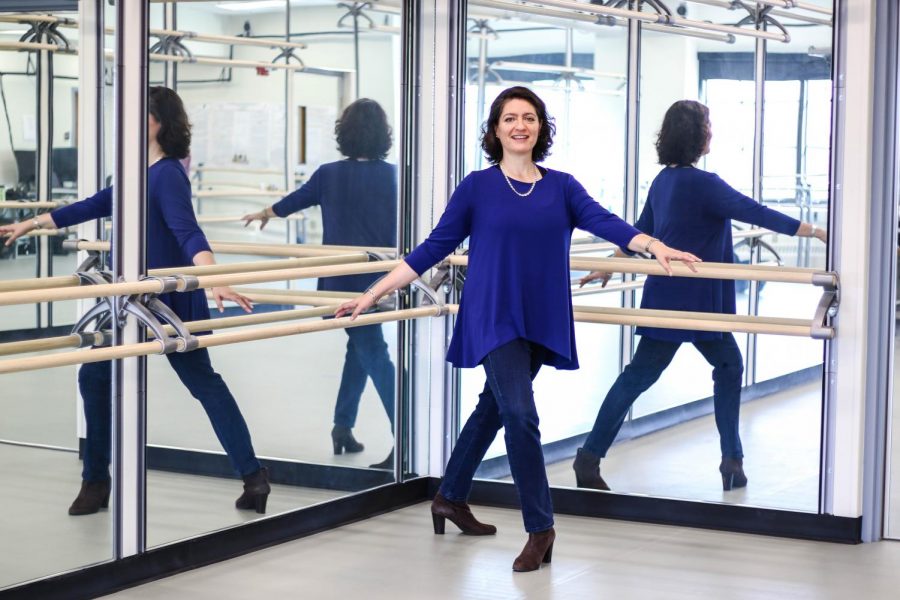Professor explores impact of dance on disabilities
Dr. Citlali Lopez-Ortiz serves as pioneer for the study of movement therapy, specifically the effects ballet has on her students. Through her studies, Lopez-Ortiz has seen 50 to 60 percent of overall improvement with her subjects in her multiple sclerosis study, crediting it to the combination of motor learning and movement meditation.
Oct 4, 2018
Last updated on March 1, 2019 at 02:24 p.m.
Dr. Citlali Lopez-Ortiz is both an artist and a scientist. With a background in both ballet and biomechanics, Lopez-Ortiz combines the two as director of the Neuroscience of Dance in Health and Disability Laboratory.
Lopez-Ortiz, a lifelong ballerina, became disillusioned by the segregation of arts and science during her studies. Her advisers discouraged her from studying dance as a movement therapy. It wasn’t until she was observing therapy sessions during postdoctoral research at the Rehabilitation Institute of Chicago — now the Shirley Ryan AbilityLab — did Lopez-Ortiz actively start studying dance and disability.
“One of the therapists was working with a baby, and she was extending the spine of the baby and moving the baby around and bringing it back in a very nice movement,” she said. “When I saw it, I thought ‘Well, that looks like a dance, just put some music to it and you’re dancing.’”
She created a ballet class for children with cerebral palsy per the recommendation of the head of research at the Rehabilitation Institute of Chicago. Given its success, Lopez-Ortiz opened her own lab at the University in 2014.
Get The Daily Illini in your inbox!
Today, her lab studies the effects of ballet and other movement therapies on children and adults with cerebral palsy, Parkinson’s disease and multiple sclerosis. She carefully designs ballet classes to assess muscle control and improvement in subjects over several weeks.
In her multiple sclerosis study, her ballet therapy saw 50 to 60 percent overall improvement in her subjects, high in comparison with other exercise interventions that cite only 10 to 16 percent improvement.
Lopez-Ortiz hypothesized their success could be the combination of motor learning and movement meditation that comes from ballet and their collective potential to create myelin in the brain.
“In multiple sclerosis, myelin is lost,” she said. “Myelin is a sheet of connective tissue that wraps around neurons that increases the speed of the conduction of the signals of the neurons. When the myelin is lost due to the attacks from the autoimmune system, then the speed of communication between the neurons is lessened and problems arise in coordination, cognition and processing in general.”
She said existing medication for multiple sclerosis addresses autoimmune function, however, it’s not addressing rebuilding the myelin lost. Lopez-Ortiz said because the patients are able to learn, she and others involved think they might be creating new myelin.
Currently, Lopez-Ortiz and her team are searching for multiple sclerosis participants for another round later in the fall. This time, she will have access to brain imaging which will allow them to see if new myelin is created as a result of the dance therapy.
Research assistant Nicole Alberto, senior in AHS, has been with Lopez-Ortiz since her sophomore year. She has stayed because the research is hands-on and unique, and only occasionally a source of frustration when facilitating any kind of background research.
“That’s the problem I was having when I was looking for articles related to her research,” Alberto said. “I was only getting a few results because not a lot of people are doing it.”
Lopez-Ortiz said there are only 11 articles published so far on dance movement and music therapy in relation to cerebral palsy, one of them being hers. She believes the lack of literature is due to the divide between art and science.
“If you have a scientist on one side and a dancer on the other side, the languages they do speak are so different that there is very little communication across,” she said. “So you need people who speak both to provide linkages.”
Angela Johnson, the mother of one of Lopez-Ortiz’s former students Larke Johnson who has a mild form of cerebral palsy, has seen the positive results of the dance movement therapy firsthand.
“Sometimes her muscle tone fluctuates, so sometimes she’s very stiff and rigid, and other times, she’s kind of loose and floppy,” she said. “Ballet makes her more present with what her body is able to do and makes her take more control. It’s been a wonderful mode of expression for her.”
Larke continues to dance today at the Joffrey Ballet in Chicago, even having the opportunity to dance in “The Nutcracker” thanks to Lopez-Ortiz.
Lopez-Ortiz realizes dance has many emotional benefits, especially for those with these diseases.
“Even if you can’t improve quality of movement, you’re improving the quality of life through participation,” she said.
Lopez-Ortiz’s innovative research is reaching more people too. One mother of a child with cerebral palsy contacted Lopez-Ortiz to start a ballet class in Orange County, California. Lopez-Ortiz cites helping these children improve their lives as the greatest reward.
“Seeing the kids really empowered, they get to express themselves artistically and emotionally and their humanity comes through,” she said. “In dance, the instrument is the body. So it’s you, so it’s so much about the person and the human behind that.”






